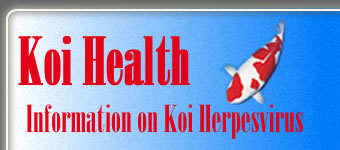
THE BIOSECURE FACILITY CONCEPT
A complete understanding and correct application of the Biosecure Facility Concept is essential to the isolation and control of infectious disease in the facility. Biosecurity refers to the protection of our fish from infectious diseases. Biosecurity procedures are the means by which we protect our koi from infectious disease, or in the event we have disease, keep it from spreading to other koi. When infectious material moves from sick or recovered fish to susceptible fish, disease transmission occurs. Biosecurity procedures are designed to prevent the transfer of this infectious material between groups of fish.
A hobbyist collection, an aquaculture dealer, or retail facility may consist of a small number of display tanks, a pond in the backyard, limited ponds in a garden center area, many ponds over several acres, or buildings housing many ponds. The market of individual aquaculture facilities may be quite varied. Some facilities may be working with small collections of expensive specimens and each individual specimen must exhibit excellent health in order to maintain or appreciate in value. Other facilities may maintain large quantities of koi for the pond trade. Others may keep small backyard breeding ponds where they produce a few fry to enjoy and to earn income to offset their expenses. Individual hobbyists may casually maintain a few fish for enjoyment or strive to maximixe koi potential thru excellent husbandry for show. Although the goals of these individual koi facilities and hobbyists may vary, the success of all establishments depends upon their implementation of good husbandry and biosecurity practices. As stewards for our respective koi, it becomes our obligation to protect our aquatic charges from inadvertant introduction of life threatning infectious disease. Application of principles of the biosecure facility concept reduce this risk of infectious disease.
The goal of the biosecure facility is to prevent the introduction of pathogenic organisms into the facility, and when this is not possible, controlling or eliminating disease in the facility. Some pathogens, such as koi herpesvirus (KHV) warrant special precautions and specific management protocols. In addition to new stock, there are other potential sources for entry of infectious organisms into the facility. These might include contamination of the water or food supply, animal or predator vectors, asymptomatic carriers within the existing stock, and spread of infectious agents on humans and equipment.
Additionally most facilities utilize recirculation systems. Usually fish are at relatively high density, with a relatively low water turnover. There may be a buildup of sediment in tanks or filtration components ultimately leading to a concentration of potential pathogens. Biosecurity practices are important in not only preventing the introduction of severe disease causing pathogenic organisms but also in reducing the numbers of potential pathogens in the systems and their potential transfer between systems. Good husbandry, in addition to quarantine, diagnostics, sanitation and disinfection, is a key component of facility biosecurity.
Implementation of the Biosecure Facility Concept includes defining separate areas within the establishment, each with a distinct location. These areas include the following:
(1) Quarantine Area. This is where all new koi are housed for observation and appropriate testing until it is safe to transfer them to the display area. This location is the primary defense for the isolation and control of infectious disease, before the fish are mixed with others in the facility. The quarantine area should be serviced after all other areas are serviced. Access to the quarantine area is restricted. Additional information and guidelines regarding the quarantine area follow.
(2) Display area(s). These ponds or tanks are for those fish which have completed the quarantine process, and have shown no evidence of infectious disease after appropriate testing. These would usually be the tanks or ponds from which koi sales are made.
(3) Hospital Area. (optional) This usually refers to smaller systems in which individual fish or groups of fish may be kept isolated for medication or other treatment. This area must be separate from the quarantine area. Separate equipment must be maintained for this area and access must be limited. Measures to prevent transfer of pathogens from the hospital area to the rest of the facility are similar to those used for the quarantine area.
(4) Food Storage and Supply Area. Food storage, preparation and wash areas may be combined. Planning and monitoring traffic flow between each area in the establishment is the critical element in preventing and controlling disease transmission. Access to the food storage/supply area should not be through a quarantine, hospital or boarding area.
(5) Boarding Area. (optional) In the event the facility offers a boarding service for koi, the koi being boarded must be separated from other fish in the facility as if they were in quarantine. The fish must be considered potential carriers of pathogens, including KHV, and treated as if they were in quarantine. In essence, a boarding system must be treated like a quarantine system.